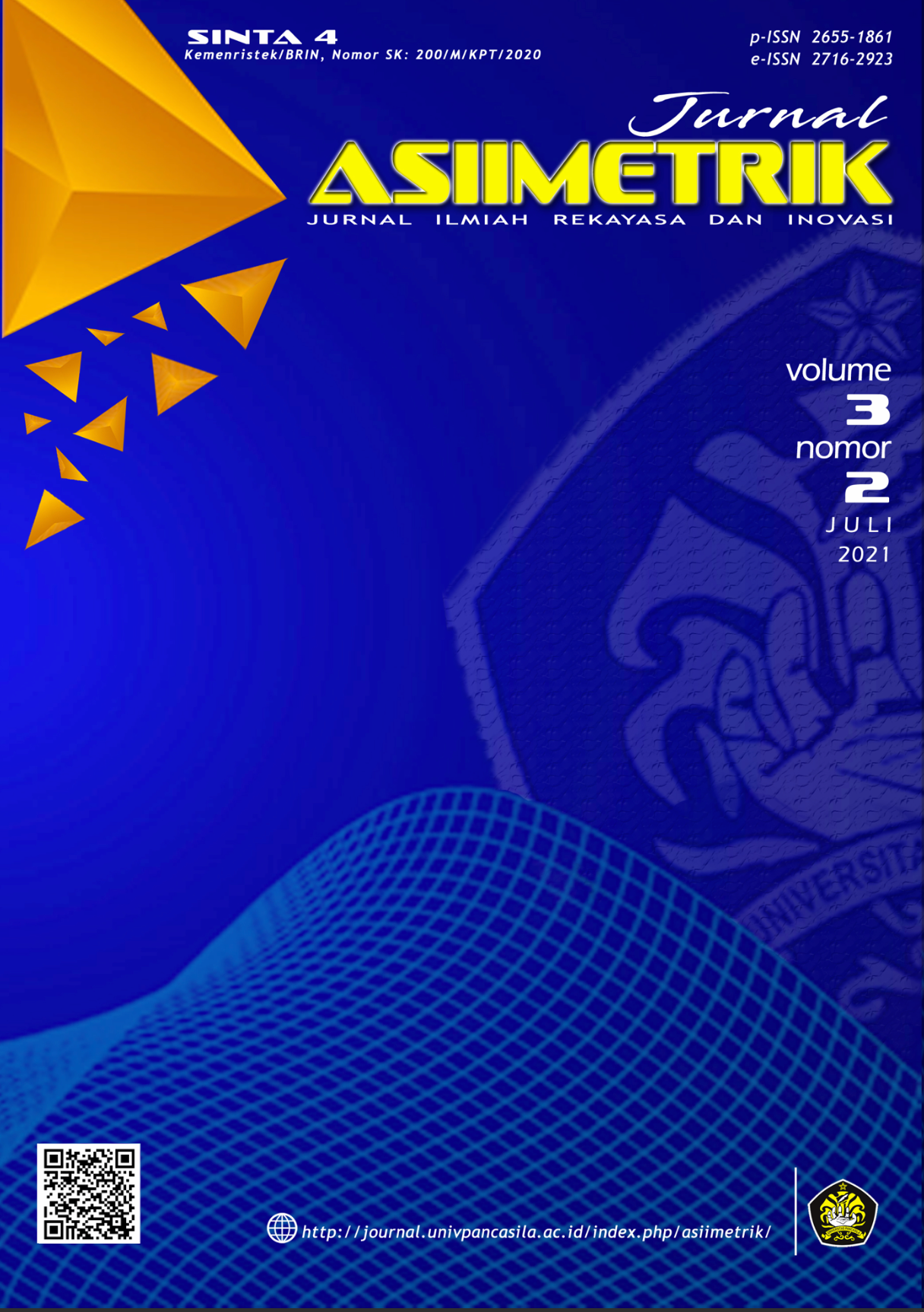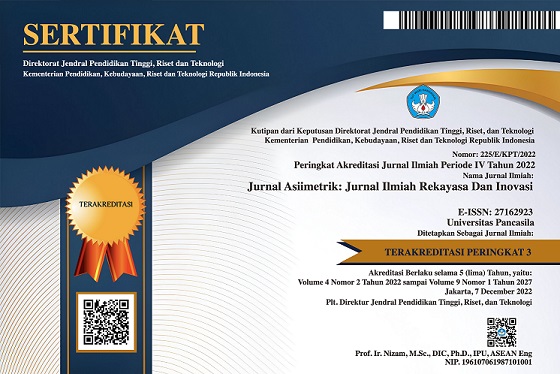Perancangan Permanent Magnet Synchronous Generator Sultan Wind Turbine V-5
Abstract views: 699 | pdf downloads: 984
Abstract
Wind is an inexhaustible source of energy so that the use of wind energy change systems will have a positive impact on the environment. Sultan Wind Turbine is a vertical axis wind turbine called the Vertical Axis Wind Turbine (VAWT). Synchronous generator is a machine that converts mechanical energy into electrical energy. Permanent magnet synchronous generator (PMSG) is a generator that uses permanent magnets to generate an air gap field instead of using an electromagnet. The purpose of this study is to design a 100 W PMSG generator for Sultan Wind Turbine using the MagNet infolytica software, then the results of looking for simulations at various speeds and various loads, after that to determine the value of the output power and efficiency at each loading and RPM. The design of this generator is the first design that is adapted to previous research where this design will optimize the simulation of previous designs that were applied to the Sultan Wind Turbine v-5. A method for designing a permanent magnet synchronous generator simulation of the sultan wind turbine which will be tested in developing its performance using the J.R. Handershot. In this design using MagNet Infolytica software to find the values of Voltage and Current along with Torque obtained from simulations with the finite element method, then data processing is carried out in Excel to find the value of output power and efficiency. The results obtained in this study are by changing the geometric shape. able to produce with a rotating speed of about 100 rpm to 150 rpm at a load of 5 ohms, namely 125, 86 Watt to 231.59 Watt. The average DC voltage is 33.5 volts, the average DC current is 6.65 Ampere, the torque is 23. 24 Nm, the input power is 365.14 Watts, the output power is 231.59 Watts and the efficiency ranges from 58% to 79%.
References
Afirianto, I., dan Rangga, Muhamad. 2018. Analisa Efisiensi dan Rancang Generator Permanent Magnet 12 Slot 8 Pole Menggunakan Software Magnet 7.5. Seminar Nasional Microwave, Antena dan Propagasi (SMAP), hal. 43-47.
Akin, E., 1994. Finite Elements for analysis And Design. London : Academic Press, inc.
Chapman, S.J., 2012. Electric Machinery Fundamentals 5th Edition., New York: Mcgraw-Hill.
Erwin, E. dkk., 2018. The Effect of Hybrid Savonius And Darrieus Turbine On The Change Of Wake Recovery And Improvement Of Wind Energy Harvesting. Journal of Applied Engineering Science. 16(3), hal. 416–423.
Erwin, E. dkk., 2019. Performance Investigation of Dual Shaft Hybrid Vertical Turbines Using Directional Fins. Eastern-European Journal of Enterprise Technologies ISSN. 5(8), hal.53–58.
Fish, Jacob dan belytschko., 2007. A First Course in Finite Elements., USA: Willey.
Fitzgerald. A. E, Kingsley Jr. Charles, dan Usmans Stephen., 2003. Electric Machinery (sixth Editions. New York: McGraw-Hill.
Gerrit Mur., 1994. Edge element, their advantages and their disanvatages. IEEE trans, On magnetics. 30 (5). hal. 3552-3557.
Gieras. F. J., 2017. Electrical machines: Fundamentals of electromechanical Energi Conversion. Florida, US: CRC Press.
Gieras. F. J., 2010. Permanent Magnet Motor Technology : Design And Aplication (Third Edition). Florida: CRC Press.
Guo, Z., Chang, L., 2005. Fem Study On Permanent Magnet Synchronous Generators For Small Wind Turbines. IEEE CCECE/CCGEI., 05, hal. 641-644.
Hamzah, A., Suwitno, S., Irfan, I., Kurniawan, I., gussyafri. H., Susanto, H., dan Tsitsino, T. 2020. Design and Simulation of Permanent Magnet Synchronous Generators for Small Scale Wind Power Plants. International Conference on Renewable Energy Research and Challenge: E3S Web of Conferences, 120, hal. 1-8.
Hendershot, J.R., dan Miller, T., 1994. Design Of Brushless Permanent Magnet Motors. New York, USA : Magna Physics Publishing And Oxford University.
Hanselman, Duane., 2006. Brushless Permanent Magnet Motor Design (Second edition). Ohio, US: Magna Physics Publishing.
Jin, J., 1993. The finite element method in Elektromagnetics. John., New York : Willey and sons.
Kenjo, T., dan Nagamori, S., 1985. Permanent – Magnet And Brushless DC Motors, New York: Oxford University Press.
Krishnan, R., 2017. Permanent Magnet Synchronous and brushless DC motor drives. Florida, US: CRC Press.
Madani, N. dkk., 2015. A Permanent Magnet Synchronous Generator For Small Scale Vertical Axis Wind Turbine. IEEE. 15, hal.48–52.
Moaveni, Saeed., 1999. Finite Element Analysis. Theory and Apllication with ANSYS’., New Jersey : Prentice-Hall, Inc.
Sadarangani, C., 2006. Electrical Machines: Design And Analysis of Induction And Permanent Magnet Motors. Stocholm, Sweden: Royal ins, of tech.
Simanjuntak, P.A., 2014. Perancangan Motor/Generator Dengan Software Magnet, Modul Pembelajaran. Lentera Bumi Nusantara, Cuheras, Jawa Barat.
Sutrasno, 2004. Aplikasi Metode Elemen Hingga Pad Masalah Gelombang Elektromagnetik. Widyanuklida. 5(2), hal. 34-38
Tim Penulis Lentera Bumi Nusantara., 2017. Profil Lentera Bumi Nusantara. Tasikmalaya, Jawa Barat.
Umami, M. 2018. Desain Generator Sinkron Magnet Permanen Jenis Neodymium Iron Boron Untuk PLTB Daya 500 watt Menggunakan Perangkat Lunak MagNet Infolytica. Skripsi, Fakultas Teknik, Teknik Elektro, Universitas Mataram, NTB.


























